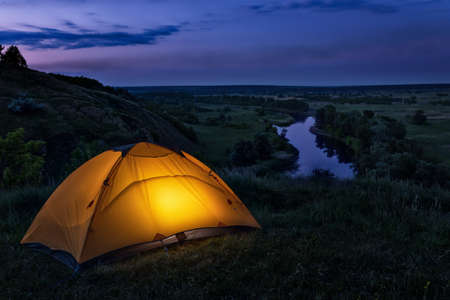1. Choosing the Wrong Campsite
One of the most common mistakes new and even experienced campers make is picking a poor spot to pitch their tent. Where you set up can make or break your camping experience, so it’s worth taking a few extra minutes to choose wisely.
Why Campsite Selection Matters
A bad campsite can lead to uncomfortable sleep, water pooling in your tent, or even dangerous situations. Sloped ground will have you sliding all night, while low-lying areas can flood if it rains. Flat, dry ground is always your best bet.
What to Look for in a Good Campsite
| Feature | Why It Matters |
|---|---|
| Flat Terrain | Prevents sliding around in your sleep and makes setup easier. |
| Well-Drained Ground | Keeps your tent dry even during unexpected rain. |
| Away from Low-Lying Areas | Reduces the risk of flooding during storms. |
| No Overhead Hazards | Protects you from falling branches or debris. |
Scout Before You Set Up
Before unpacking your gear, walk around and assess the area. Look for flat ground that isn’t at the bottom of a hill or near a stream. Check for signs of previous campers—these spots are often already cleared and safer. Also, look up—avoid setting up under dead branches or leaning trees that could fall in strong wind.
Pro Tip:
If youre camping in a national park or designated campground, use established tent pads when available. Theyre specifically designed for safe and comfortable camping.
2. Ignoring the Wind Direction
Setting up your tent without considering the wind direction is one of the most common rookie mistakes in camping. Failing to take the wind into account can lead to a wobbly, noisy, or even damaged tent. But with a little planning, you can avoid all that and enjoy a peaceful night outdoors.
Why Wind Direction Matters
When wind hits your tent broadside, it creates more resistance and pressure on the structure. This can cause your poles to bend, stakes to loosen, or worst-case scenario—your tent could collapse. Even if it holds up, the flapping fabric will keep you up all night.
How to Pitch Your Tent According to Wind
The key is to minimize surface area facing the wind and use nature as your shield when possible. Heres what you should do:
Tips for Setting Up with Wind in Mind
| What to Do | Why It Helps |
|---|---|
| Face the narrow end of your tent into the wind | Reduces drag and keeps your tent stable |
| Use natural windbreaks like trees or bushes | Blocks gusts and protects your setup |
| Tighten guylines and stake securely | Keeps everything in place during strong winds |
| Avoid setting up on exposed ridges or hilltops | These spots often have stronger and more unpredictable winds |
Quick Test: Finding Wind Direction
You don’t need fancy gear to figure out where the wind’s coming from. Just toss some grass in the air or lick your finger and hold it up—the cool side faces into the wind. Once you know that, rotate your tent accordingly.
Bonus Tip: Listen Before You Pitch
If youre unsure about wind conditions, take a few minutes before setting up to observe how trees move or listen for rustling leaves. Nature gives clues—you just have to pay attention.
By thinking ahead and adjusting for the wind, you’ll create a stronger, quieter campsite setup that lets you sleep soundly through the night.

3. Improper Tent Orientation
One of the most overlooked aspects of pitching a tent is which direction its facing. It might seem like a small detail, but getting this wrong can make or break your camping experience. From enjoying scenic views to staying dry during an unexpected downpour, proper tent orientation plays a big role in your overall comfort and safety.
Why Tent Orientation Matters
Setting up your tent with intention can help you take full advantage of your campsite. Whether its catching the morning sun to warm up after a chilly night or avoiding strong winds that could flap your rainfly all night, orientation affects it all.
Key Factors to Consider
| Factor | Why It Matters | Tips |
|---|---|---|
| Sun Exposure | Morning sun can help dry out condensation and warm you up. | Face your tent door east for sunrise light. |
| Wind Direction | Avoid having wind blow directly into vents or doors. | Position the lowest side toward prevailing winds for stability. |
| Rain Protection | Poor orientation can let rain enter through doors or vents. | Keep doors away from the direction rain is likely to come from. |
| Scenic Views | You dont want to miss out on a great view because of bad positioning. | Check your surroundings and face your tent toward lakes, mountains, or sunsets. |
Pro Tip
If youre unsure about the weather conditions, ask a park ranger or check a weather app before setting up. Knowing the typical wind direction and sunrise/sunset times can help you decide how to orient your tent more effectively.
A Quick Checklist Before You Stake Down:
- Where will the sun rise and set?
- Which way is the wind blowing?
- Is there any slope? Face uphill if possible to avoid water pooling at the door.
- What’s the best view from your site?
A little planning goes a long way when it comes to tent orientation. Not only can it improve your comfort, but it also makes waking up in nature that much more enjoyable.
4. Skipping the Ground Tarp
One of the most overlooked steps in tent setup is using a ground tarp or footprint. This simple layer goes underneath your tent and plays a huge role in protecting it from wear and tear, moisture, and sharp objects on the ground.
Why You Need a Ground Tarp
A ground tarp acts as a barrier between your tent floor and the ground. It helps prevent water from seeping in during rain, keeps dirt and debris off your tent bottom, and extends the life of your gear by reducing abrasion.
Common Mistakes When Using a Tarp
| Mistake | What Happens | How to Fix It |
|---|---|---|
| Tarp is too large | Water can collect on the tarp and flow under your tent | Fold or trim the tarp so it’s slightly smaller than your tent’s base |
| Tarp is placed incorrectly | The tent may slide or be uneven; water protection is reduced | Lay the tarp flat with no wrinkles and centered under the tent body |
| No tarp used at all | Tent floor wears out faster; increased risk of leaks and tears | Always pack a properly sized tarp or footprint for every trip |
Choosing the Right Size
Your ground tarp should be just slightly smaller than the base of your tent. If it sticks out beyond the edges, rainwater can collect on it and run underneath your shelter—exactly what you don’t want. Many tent brands offer custom-fit footprints designed specifically for their models. If youre using a generic tarp, fold the edges under until its a perfect fit.
Pro Tip: Use Tent Footprints When Possible
If youre serious about camping regularly, investing in a footprint made by your tents manufacturer can be worth it. Theyre durable, lightweight, and shaped to fit your specific model—making setup faster and more efficient.
5. Overlooking Guy Lines and Stakes
Many campers underestimate the importance of properly securing their tent. It’s easy to think that just setting up the main structure is enough, especially on calm days. But guy lines and stakes play a huge role in keeping your tent stable, dry, and comfortable—especially when the weather turns.
Why Stakes and Guy Lines Matter
Stakes anchor your tent to the ground, preventing it from shifting or collapsing in wind. Guy lines help pull the rainfly away from the inner tent, improving ventilation and preventing condensation buildup. Skipping these steps can lead to a soggy sleeping bag or even a flattened tent overnight.
Common Mistakes Campers Make
| Mistake | Why Its a Problem | How to Avoid It |
|---|---|---|
| Not using all guy lines | Less stability, poor airflow inside the tent | Always use every guy line provided, especially in windy or rainy conditions |
| Poor stake placement | Stakes can come loose easily or not hold tension | Insert stakes at a 45-degree angle away from the tent for maximum grip |
| Using the wrong type of stakes | Some stakes don’t hold well in certain soil types | Bring different types: Y-stakes for hard ground, spiral stakes for sand or loose soil |
| Not tightening guy lines | Loose lines reduce tension and effectiveness | Use line tensioners or taut-line hitches to keep everything snug |
Quick Tips for Proper Setup
- Check wind direction: Stake the side facing the wind first to prevent your tent from blowing away mid-setup.
- Tension evenly: Make sure all guy lines are pulled tight and evenly spaced for balanced support.
- Recheck daily: Stakes can loosen overnight due to weather or shifting ground—give them a quick check each day.
If you take the time to use your guy lines and stakes properly, you’ll enjoy a more secure, breathable, and weather-resistant shelter throughout your trip.
6. Setting Up Without a Dry Run
Trying to pitch a new tent for the first time in the wild can be a recipe for frustration. It might seem like a simple task—pull it out of the bag, pop in some poles, and stake it down—but real-world conditions like wind, uneven ground, or missing pieces can turn that quick setup into a stressful ordeal.
Why You Should Practice at Home
Setting up your tent at home before heading out on your trip helps you:
- Understand the setup process: Some tents have unique designs or multi-step instructions that aren’t obvious at first glance.
- Check for missing parts: It’s better to discover a missing stake or pole in your backyard than when youre miles from the nearest store.
- Save time at camp: Familiarity speeds up setup, especially if daylight is fading or weather conditions are tough.
What to Look for During Your Dry Run
| Task | What to Check |
|---|---|
| Unpack and inspect gear | Make sure all poles, stakes, rainfly, and guylines are included and in good condition. |
| Practice pitching | Follow instructions step by step; note any confusing steps or tight fits. |
| Test takedown and packing | Practice folding and fitting everything back into its bag efficiently. |
Pro Tips for First-Time Setups
- Watch online videos: Many manufacturers post setup tutorials on YouTube.
- Label parts: Use colored tape or tags to identify similar-looking components quickly.
- Time yourself: Knowing how long it takes helps you plan better at camp.
A Little Prep Goes a Long Way
A dry run may only take an hour at home, but it can save you from hours of stress in the wilderness. Plus, practicing gives you confidence and lets you focus on enjoying your camping adventure instead of fumbling with gear when you arrive.


